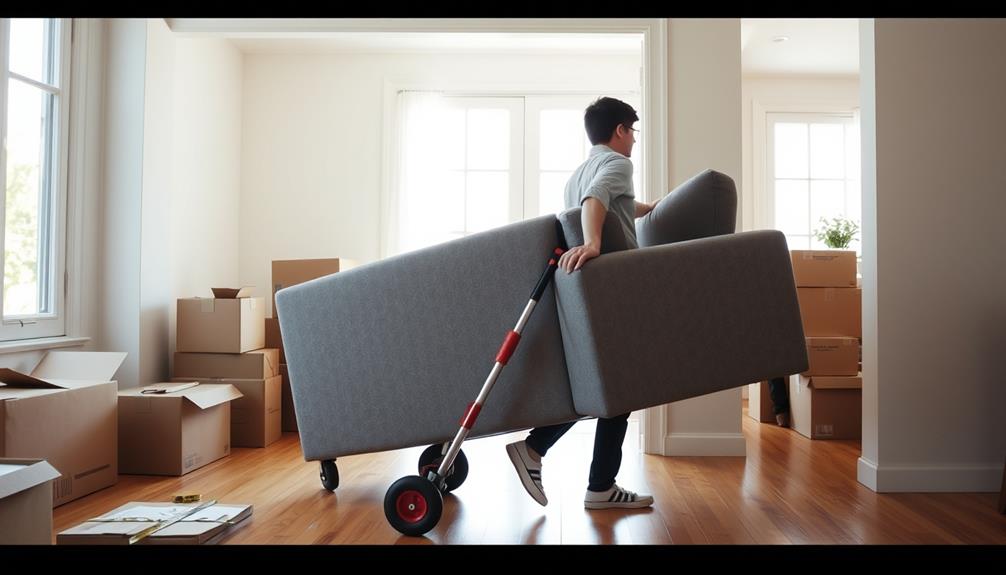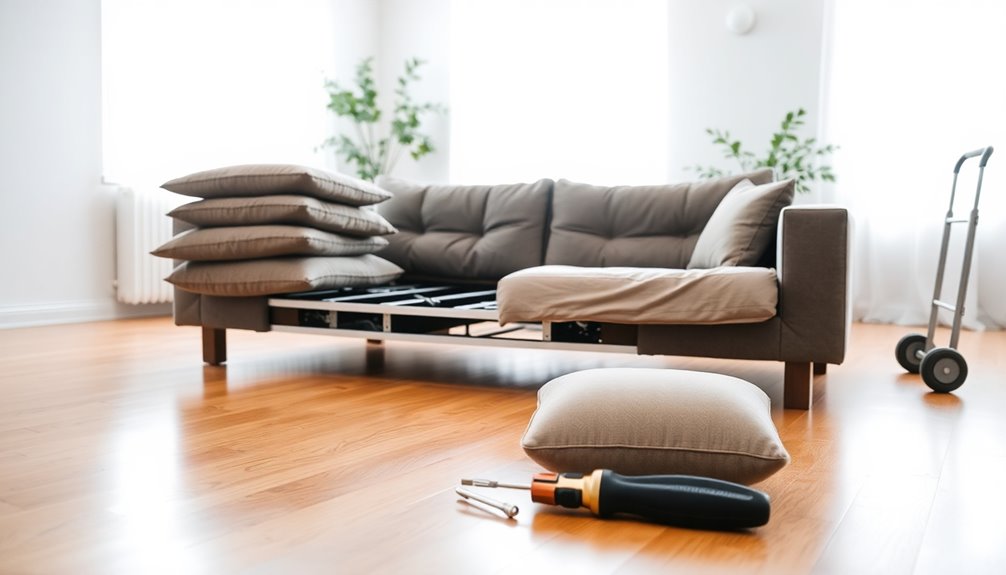When preparing a sofa for moving, the first step is to remove all cushions and pillows. After that, make sure to have necessary tools like screwdrivers and pliers on hand. Gently cut the upholstery along the seams and take out any staples. Identify any screws or bolts on the frame and begin by taking apart the arms and legs, while labeling each piece as you progress. Wrap each part securely in moving blankets and place them in sturdy boxes for transportation. Double-check that everything is loaded securely in the moving vehicle, filling in any gaps to prevent shifting. By following these guidelines, reassembling the sofa will be simpler, and you can find more tricks to streamline the process.
Key Takeaways
- Gather essential tools, including screwdrivers, wrenches, and pliers, to effectively disassemble the sofa.
- Remove all detachable cushions and upholstery, documenting the process with photos for easier reassembly.
- Identify and systematically remove fasteners from the frame and arms, organizing them in labeled bags.
- Wrap and secure individual components using moving blankets or bubble wrap to prevent damage during transport.
- Load the vehicle with heavier items at the bottom for stability and secure all components to prevent movement.
Preparation for Disassembly
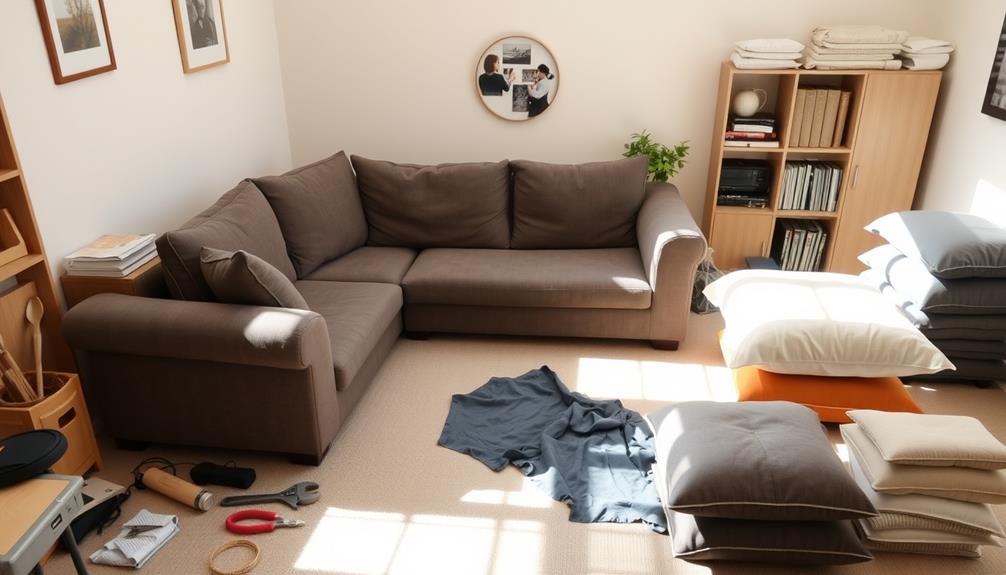
Before you plunge into taking apart your sofa, make certain you've got all the right tools at hand. You'll need a screwdriver set, Allen wrench, staple puller, and pliers to tackle the job efficiently. With these tools gathered, assess your couch's type and structure. Different designs might require unique methods for disassembly, so it's vital to understand what you're working with.
Additionally, consider setting a budget for any potential costs involved in transporting or storing the sofa, much like how you'd creating a personal budget for your finances.
Next, clear your workspace of any furniture and obstacles. A clean, organized environment not only guarantees safety but also makes the disassembly process smoother. You want to avoid tripping over items or searching for tools mid-task.
Allocate sufficient time for the entire project, as disassembling a sofa can take anywhere from 4 to 6 hours, depending on its complexity and your experience level.
As you proceed, document the disassembly process with photos or diagrams. This'll help you remember how everything fits together when it's time for reassembly in your new location.
Gathering Necessary Tools
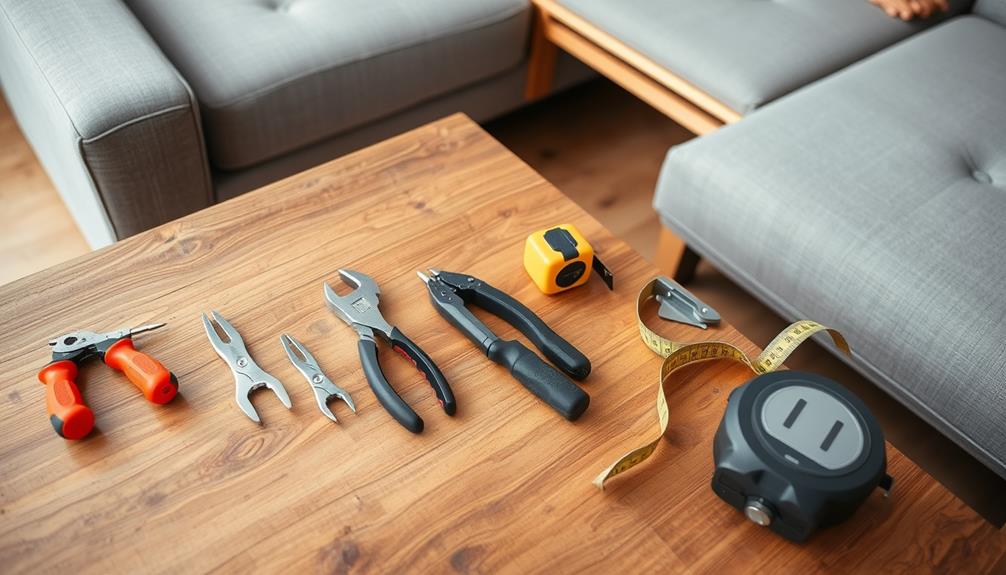
Now that you've prepared your workspace, it's time to gather the necessary tools for the disassembly. Start with a Phillips head screwdriver and a flathead screwdriver; these will help you tackle various screws on the sofa frame.
An adjustable wrench is crucial for loosening any nuts or bolts, while an Allen wrench set can be handy for specific fasteners. Don't forget heavy-duty scissors for cutting through any upholstery or fabric.
For added convenience, consider having a compact vacuum on hand to quickly clean up any dust or debris that may accumulate during the disassembly process.
Protective gear is essential during this process. Make sure to wear safety goggles and a mask to shield yourself from dust and debris, especially when handling materials or cutting fabric.
To keep things organized, have plastic bags or containers ready to store and label screws and small components. This will make reassembly much easier later on.
Additionally, prepare protective materials like moving blankets or bubble wrap to safeguard cushions and delicate parts during transport.
Cushion and Upholstery Removal
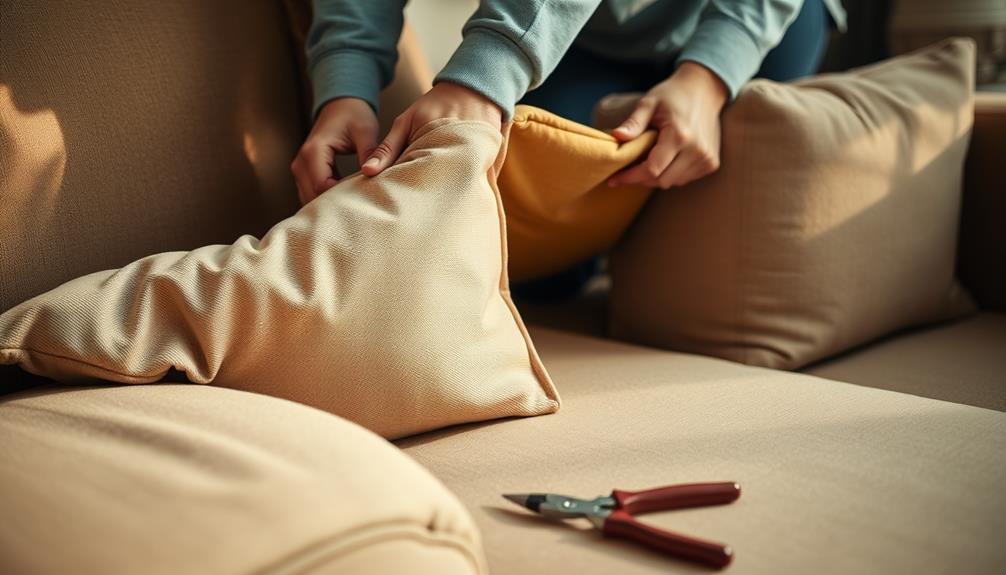
To get started with cushion and upholstery removal, first, take off all detachable cushions and pillows from the sofa. As you do this, check for any hidden items that might've slipped between the cushions. Pack these items in labeled plastic bags to avoid losing them during your move.
Regular maintenance of your furniture, like avoiding wear and tear on upholstery, can help prolong its life, similar to how preventive maintenance plans can extend the lifespan of appliances.
Next, carefully cut the upholstery fabric around the seams using heavy-duty scissors, ensuring to preserve the fabric's integrity if you plan to reuse it later.
After that, it's time to remove any staples or tacks securing the upholstery to the frame. Use a staple puller or pliers, making sure to extract all fasteners without damaging the underlying wood.
To keep everything organized, follow these steps:
- Inspect foam cushions for wear and consider recycling options.
- Store upholstery materials separately for potential donation or reuse.
- Label all removed components, including cushions and upholstery, to make reassembly easier in your new location.
Fastener Identification
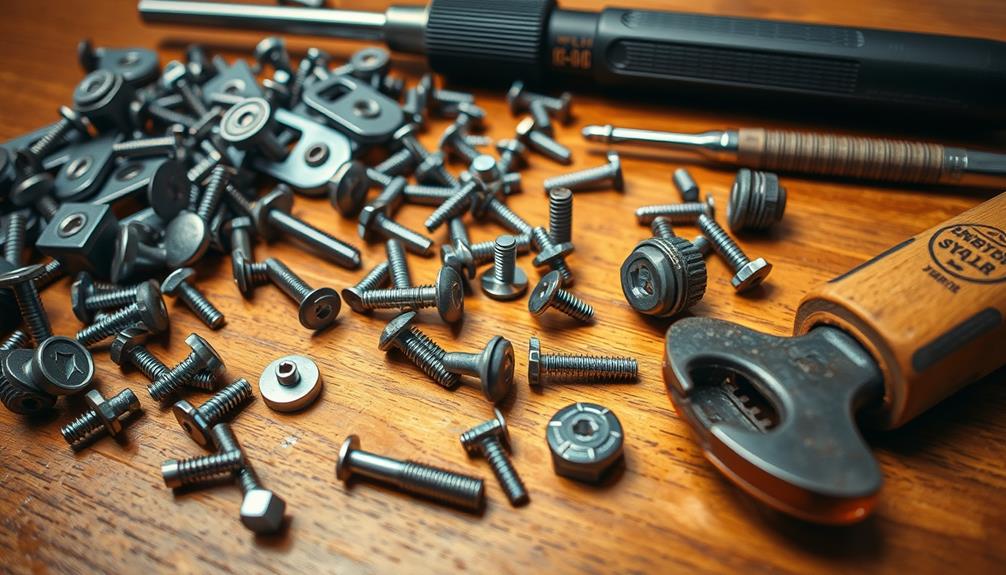
Identifying fasteners is essential for successfully taking apart your sofa. Start by inspecting the frame for visible screws, bolts, and other fasteners that hold the components together. Look carefully, as some fasteners can be hidden.
| Fastener Type | Tool Needed | Notes |
|---|---|---|
| Phillips Screws | Phillips Head Screwdriver | Commonly found in various locations. |
| Hex Bolts | Allen Wrench Set | Check for these in frame joints. |
| Wood Screws | Screwdriver or Drill | Often used in assembling the sofa. |
| Lag Screws | Socket Wrench | Usually larger and require more force. |
| Staples | Staple Remover | Can secure fabric or cushioning. |
Once you've identified the fasteners, use the appropriate tools to systematically remove screws. Keep track of their locations to avoid confusion when you reassemble the sofa. For hex bolts, confirm you have the right Allen wrench handy for quick removal. Organize the removed fasteners in labeled plastic bags or containers to make retrieval easier. Don't forget to check all joints and hidden areas for additional fasteners, as overlooking them can hinder the disassembly process and potentially damage your sofa.
Frame and Arm Disassembly
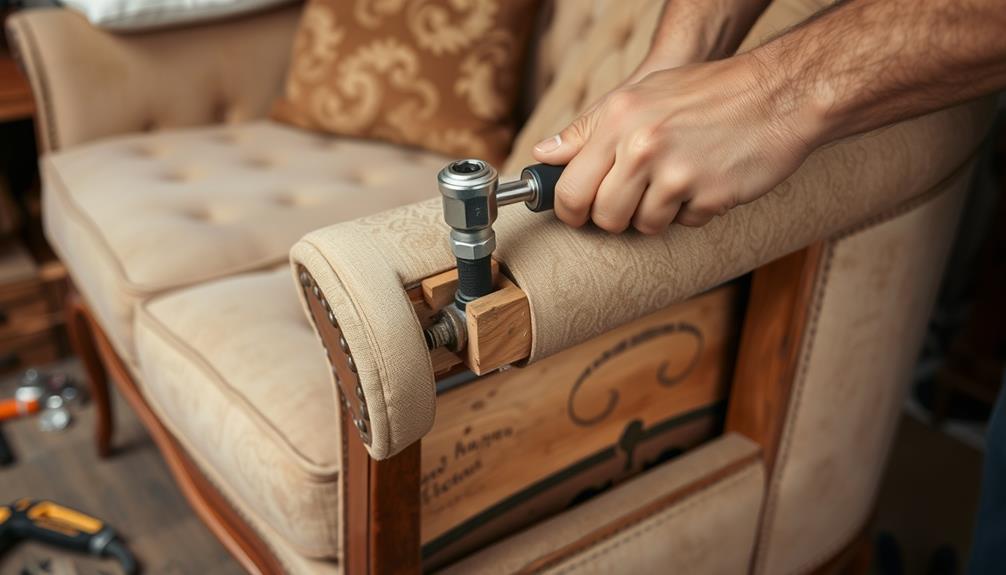
To start disassembling your sofa's frame and arms, you'll first need to identify the fasteners holding everything together. Look for screws or bolts, typically located on the arms, and gather the right tools for a smooth process.
A methodical approach won't only guarantee you keep track of all components as you work through the disassembly steps but also reflects the importance of attention to detail in achieving a successful outcome.
Following these guidelines will help you avoid potential issues during the moving process.
Identifying Fasteners and Components
Disassembling a sofa requires careful observation and attention to detail, especially when it comes to identifying fasteners and components. Start by inspecting the sofa frame for visible screws, bolts, and any hidden fasteners that might be securing the arms and other parts.
For instance, if you're experiencing discomfort during the process, consider using essential oils for stress relief, such as lavender oil, which may help calm your nerves.
Here are key steps to follow:
- Look for screws holding the arms in place, typically two per side.
- Use the right tools, like a Phillips head screwdriver or Allen wrench, to systematically remove each fastener.
- Organize fasteners in labeled bags to make reassembly easier.
If you find that the arms are secured with staples, use a staple puller to carefully remove them without damaging the fabric or frame.
After you've removed the screws, gently lift or wiggle the arms to detach them from the frame. Always be cautious of any remaining fasteners that might still be holding them in place.
Systematic Frame Disassembly Steps
After you've identified the fasteners and components, you're ready to tackle the systematic disassembly of the sofa frame and arms.
It's important to guarantee your home is secure during this process, as you may be distracted by the task at hand. the value of home security systems highlights the importance of feeling safe while working on home projects.
Start by removing any attached legs, which typically unscrew easily. This reduces the sofa's overall height and makes it easier to maneuver.
Once the legs are detached, carefully inspect the couch frame for visible screws or bolts. Use the appropriate screwdriver or wrench to methodically remove them.
If your sofa has arms, locate the screws or bolts securing them to the frame and unscrew them. Keep these fasteners organized for reassembly later.
After the arms are removed, check for any additional fasteners at the joints of the frame. Systematically remove them to break down the frame into manageable sections.
If you encounter fabric covering any screws, take care to remove the staples without damaging the material.
Label or photograph each component during disassembly. This step is vital for guaranteeing easier reassembly in your new location, especially for complex structures.
Transportation of Disassembled Parts

Once you've disassembled your sofa, it's essential to wrap each component securely to avoid scratches and damage.
Consider using protective materials like blankets or bubble wrap for maximum safety, especially if you have delicate wooden parts or upholstery.
Additionally, make certain you have recommendations for usage based on symptoms of any moving-related strains or aches.
Load the vehicle carefully, making sure everything is stable and won't shift during transit.
Securely Wrap Components
To guarantee your sofa's components stay safe during the move, secure wrapping is essential. Start by using moving blankets or bubble wrap to securely wrap each disassembled component. This provides cushioning to prevent damage during transport. Additionally, use plastic wrap or packing tape to hold the protective layers in place and ensure they don’t come undone. Labeling each wrapped piece can also help with organization during reassembly. For more tips on how to protect furniture during moving, consider using sturdy cardboard or foam padding to shield corners and delicate areas from potential impact.
Additionally, consider the importance of professional cleaning services in making certain your furniture looks its best before the move.
Next, consider these steps to enhance protection:
- Use zip ties or rope to keep wrapped components bundled together, making sure they don't shift or become loose in transit.
- Clearly label each wrapped piece to facilitate easy identification and reassembly at your destination.
- Place wrapped components in sturdy boxes or containers, filling any gaps with packing materials to prevent movement.
When packing, remember that heavier components should go at the bottom of the vehicle while lighter items sit on top. This distributes weight evenly and maintains stability during transport.
Load Vehicle Safely
Loading your vehicle safely is essential for protecting your disassembled sofa during the move. Start by wrapping all components, including frame sections and cushions, in moving blankets or bubble wrap. This protects them from scratches and damage during transport.
Additionally, consider using vacuum storage bags for cushions to save space and keep them protected from dirt and moisture, similar to the best vacuums for dust removal in 2024. Once wrapped, use zip ties or rope to secure bundled items together, preventing them from shifting or becoming loose while the vehicle is in motion.
When you load the vehicle, place heavier items, like the sofa frame, in first. Make sure they're on a flat surface to maintain stability and avoid tipping.
After that, position lighter components, such as cushions and upholstery, on top. Just be cautious not to stack anything too high to prevent it from falling during transit.
Prevent Movement During Transit
When transporting disassembled sofa parts, preventing movement during transit is crucial to avoid damage. Start by wrapping each component individually with blankets or bubble wrap. This protects them from scratches and impacts.
In addition, consider the importance of having the right essential camping gear to guarantee a successful outdoor experience. Next, securely bundle the wrapped parts together using zip ties or rope to prevent shifting and disorganization.
When you load the disassembled pieces into your vehicle, follow these tips to guarantee stability:
- Place heavier items at the bottom to maintain balance and prevent toppling.
- Use furniture sliders or cardboard under heavier pieces for easier loading and unloading while protecting your vehicle's interior.
- Fill gaps between items with cushioning materials like towels or packing peanuts to minimize movement.
Disposal and Recycling Options
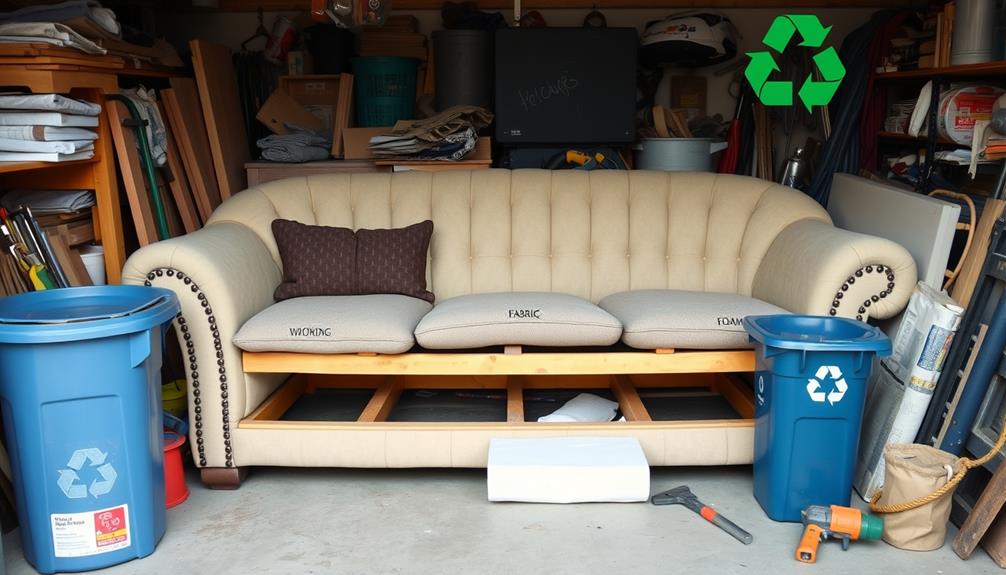
Finding responsible disposal and recycling options for your sofa can make a significant difference in reducing waste. Instead of sending your old furniture to a landfill, consider various methods to guarantee a more sustainable approach.
| Option | Description | Benefits |
|---|---|---|
| Donate | Give usable parts or entire sofas to local charities. | Promotes reuse in your community. |
| Recycling Center | Research local centers that accept furniture materials. | Eco-friendly disposal of components. |
| Eco-Friendly Facility | Investigate facilities that specialize in furniture recycling. | Helps reduce environmental impact. |
| Upcycle | Transform old cushions into pet beds or other items. | Extends the life of materials. |
| Junk Removal Service | Use services like 1-800-GOT-JUNK? for responsible disposal. | Minimizes landfill contribution. |
Tips for Reassembly
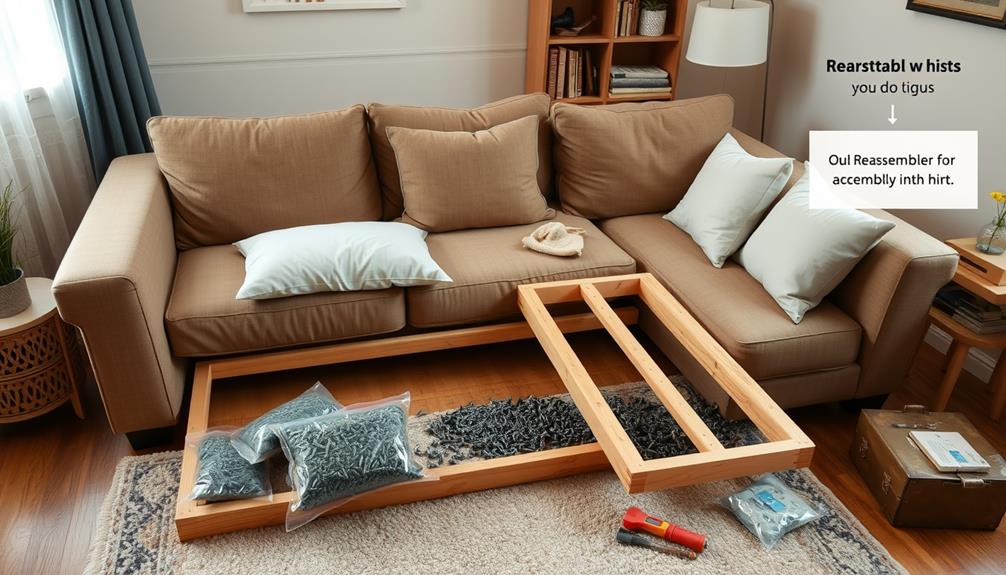
Reassembling your sofa can feel like putting together a complex puzzle, but with the right approach, it becomes a straightforward task. To make the reassembly process smoother, keep these tips in mind:
- Label all parts and fasteners: Use clearly marked bags or containers to identify each component easily during reassembly. This organizational method mirrors the building and legal considerations for tiny houses, guaranteeing you can efficiently manage all elements of your move.
- Refer to photos or diagrams: Check any images you took during disassembly to guide you and guarantee all components align properly.
- Follow the reverse order: Start with the frame, securing any legs or arms first to maintain stability.
As you reassemble, take your time to avoid damaging the upholstery or frame components.
Make certain all fasteners are tightened securely, as loose connections can compromise the sofa's stability and safety. If you encounter any difficulties, don't hesitate to revisit your photos or diagrams.
This methodical approach will help you achieve a seamless reassembly, allowing you to enjoy your sofa in its new home without hassle.
Frequently Asked Questions
Can You Take Apart a Sofa to Move?
Yes, you can take apart a sofa to move it. Disassembling it simplifies transport, especially in tight spaces. Just remember to gather the right tools, and organize your screws and parts for easy reassembly.
Can You Take Apart a Couch to Fit Through a Door?
You can definitely disassemble a couch to squeeze through a doorway. Start by swiftly unscrewing the legs and arms, simplifying the shape. Always measure beforehand to guarantee a snug, successful fit.
How to Break Down a Sofa for the Dump?
To break down a sofa for the dump, start by removing upholstery and cushions. Use tools to unscrew and cut the frame. Label screws for potential reassembly and consider recycling options for responsible disposal.
How to Disassemble a One Piece Couch?
To disassemble a one-piece couch, start by removing cushions and checking for hidden items. Unscrew the arms and legs, then look for additional screws to separate the seat from the back. Keep parts organized!
Conclusion
Disassembling your sofa is like solving a puzzle; it takes patience and attention to detail. By following these steps, you can guarantee a smooth moving process and protect your furniture from damage. Remember to label all parts and fasteners, making reassembly a breeze. Whether you're relocating across town or to a new city, being organized will save you time and stress. Now, you're ready to tackle your move with confidence!

